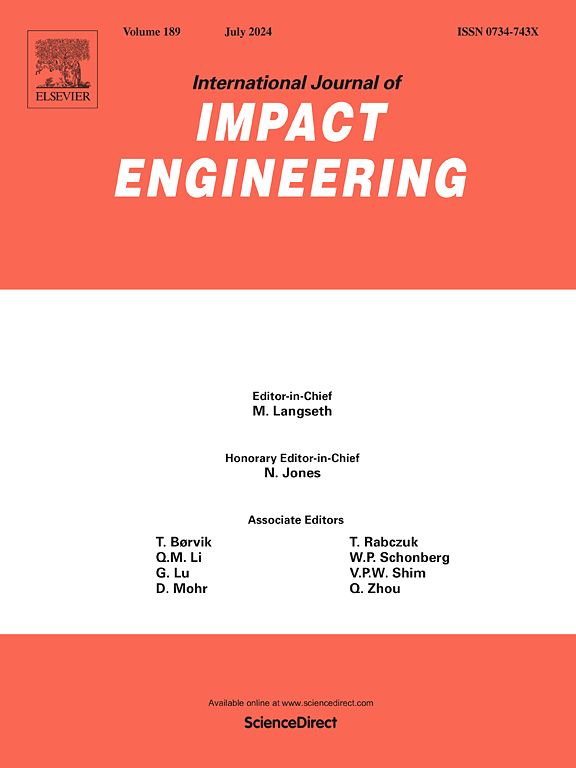不同加载速度和加载方式下钢/铝预孔自穿铆接接头力学性能及破坏机理的实验与数值研究
IF 5.1
2区 工程技术
Q1 ENGINEERING, MECHANICAL
International Journal of Impact Engineering
Pub Date : 2025-06-25
DOI:10.1016/j.ijimpeng.2025.105453
引用次数: 0
摘要
目前的研究缺乏对预孔自穿孔铆接(PH-SPR)接头在动态载荷条件下的力学响应的全面理解,类似于车辆碰撞。因此,本研究在准静态加载速度(3.0 mm/min)到动态加载速度(1.0 m/s、3.0 m/s和6.0 m/s)范围内,系统地评估了孔径和板厚对三种加载类型(剪切、剥离、交叉拉伸接头)的影响。此外,还建立了PH-SPR节点的数值模型,分析了不同加载条件下节点的破坏机理。结果表明,在准静态载荷下,较厚的薄板厚度可以提高峰值载荷,对剥离接头的影响更为显著。随着孔直径的增大,J16组(钢板厚度为1.6 mm)的峰值荷载下降率高于J12组(钢板厚度为1.2 mm)。在动加载作用下,由于应变速率效应,峰值剪切荷载随加载速度的增加呈线性增长。加载速度对1.2 mm钢板厚度和5.5 mm孔径的影响更为显著。剪切节理、剥落节理和交叉张拉节理的峰值荷载随加载速度的增加而增加,其中交叉张拉节理的峰值荷载增加幅度较大。确定了两种失效模式:联锁失效和上板失效。破坏模式主要受孔直径和板厚的影响,加载方式和加载速度主要影响板的变形行为。预钻孔的变形会导致载荷分布不均匀,进而导致节理破坏。本文章由计算机程序翻译,如有差异,请以英文原文为准。
Mechanical properties and failure mechanism of steel/aluminum pre-holed self-piercing riveted joints under different loading speeds and loading types: An experimental and numerical investigation
Current research lacks a comprehensive understanding of the mechanical responses of pre-holed self-piercing riveted (PH-SPR) joints under dynamic loading conditions, similar to those experienced in vehicle collisions. Thus, this study systematically evaluates the effects of hole diameters and sheet thickness on three loading types (shear, peel, cross-tension joints) across a range of loading speeds from quasi-static (3.0 mm/min) to dynamic conditions (1.0 m/s, 3.0 m/s, and 6.0 m/s). Additionally, numerical models of PH-SPR joints are developed to analyze the failure mechanisms under various loading conditions. Results indicate that under quasi-static loading, thicker sheet thickness can improve peak load and has a more significant impact on the peel joints. The decreasing rates in the peak load of the J16 group (steel sheet thickness is 1.6 mm) are higher than that of the J12 group (steel sheet thickness is 1.2 mm) as the hole diameter increases. The peak shear load shows a linear increase with loading speed due to the strain rate effect on steel under dynamic loading. The 1.2 mm steel sheet thickness and 5.5 mm hole diameter are more significantly affected by loading speed. The peak loads for shear, peel, and cross-tension joints increase with the loading speed, with cross-tension joints demonstrating a higher increasing rate. Two failure modes, interlock failure and upper sheet failure, are identified. Furthermore, failure modes are primarily influenced by hole diameter and sheet thickness, while loading type and loading speed mainly affect the sheet deformation behavior. The deformation of pre-drilled holes can lead to uneven load distribution and subsequent joint failure.
求助全文
通过发布文献求助,成功后即可免费获取论文全文。
去求助
来源期刊

International Journal of Impact Engineering
工程技术-工程:机械
CiteScore
8.70
自引率
13.70%
发文量
241
审稿时长
52 days
期刊介绍:
The International Journal of Impact Engineering, established in 1983 publishes original research findings related to the response of structures, components and materials subjected to impact, blast and high-rate loading. Areas relevant to the journal encompass the following general topics and those associated with them:
-Behaviour and failure of structures and materials under impact and blast loading
-Systems for protection and absorption of impact and blast loading
-Terminal ballistics
-Dynamic behaviour and failure of materials including plasticity and fracture
-Stress waves
-Structural crashworthiness
-High-rate mechanical and forming processes
-Impact, blast and high-rate loading/measurement techniques and their applications
 求助内容:
求助内容: 应助结果提醒方式:
应助结果提醒方式:


